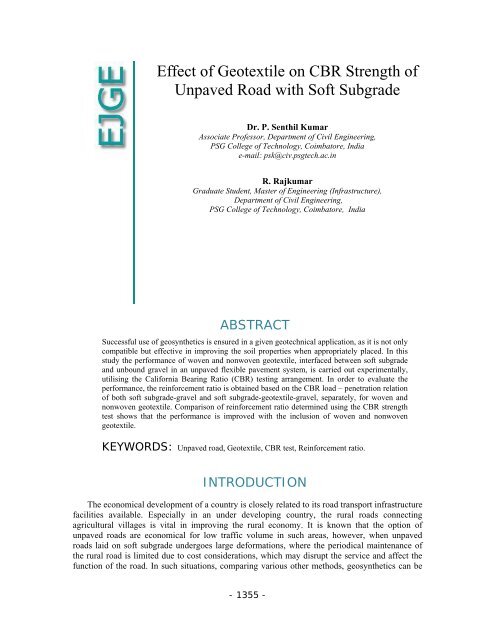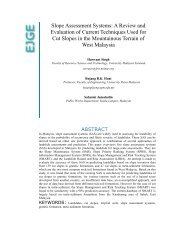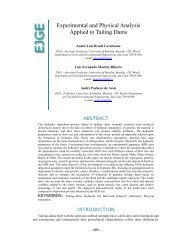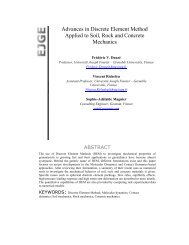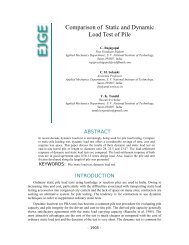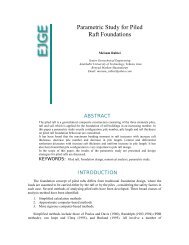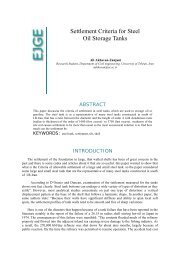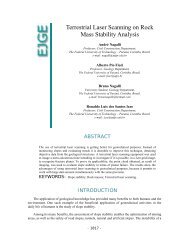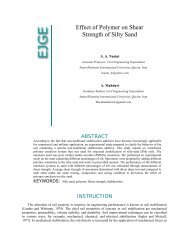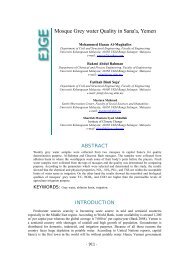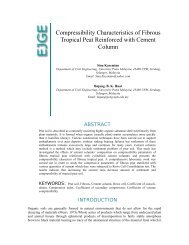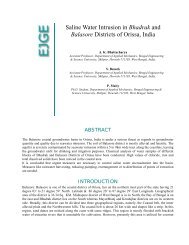Get the entire paper (pdf) - Ejge.com
Get the entire paper (pdf) - Ejge.com
Get the entire paper (pdf) - Ejge.com
Create successful ePaper yourself
Turn your PDF publications into a flip-book with our unique Google optimized e-Paper software.
Effect of Geotextile on CBR Strength of<br />
Unpaved Road with Soft Subgrade<br />
Dr. P. Senthil Kumar<br />
Associate Professor, Department of Civil Engineering,<br />
PSG College of Technology, Coimbatore, India<br />
e-mail: psk@civ.psgtech.ac.in<br />
R. Rajkumar<br />
Graduate Student, Master of Engineering (Infrastructure),<br />
Department of Civil Engineering,<br />
PSG College of Technology, Coimbatore, India<br />
ABSTRACT<br />
Successful use of geosyn<strong>the</strong>tics is ensured in a given geotechnical application, as it is not only<br />
<strong>com</strong>patible but effective in improving <strong>the</strong> soil properties when appropriately placed. In this<br />
study <strong>the</strong> performance of woven and nonwoven geotextile, interfaced between soft subgrade<br />
and unbound gravel in an unpaved flexible pavement system, is carried out experimentally,<br />
utilising <strong>the</strong> California Bearing Ratio (CBR) testing arrangement. In order to evaluate <strong>the</strong><br />
performance, <strong>the</strong> reinforcement ratio is obtained based on <strong>the</strong> CBR load – penetration relation<br />
of both soft subgrade-gravel and soft subgrade-geotextile-gravel, separately, for woven and<br />
nonwoven geotextile. Comparison of reinforcement ratio determined using <strong>the</strong> CBR strength<br />
test shows that <strong>the</strong> performance is improved with <strong>the</strong> inclusion of woven and nonwoven<br />
geotextile.<br />
KEYWORDS: Unpaved road, Geotextile, CBR test, Reinforcement ratio.<br />
INTRODUCTION<br />
The economical development of a country is closely related to its road transport infrastructure<br />
facilities available. Especially in an under developing country, <strong>the</strong> rural roads connecting<br />
agricultural villages is vital in improving <strong>the</strong> rural economy. It is known that <strong>the</strong> option of<br />
unpaved roads are economical for low traffic volume in such areas, however, when unpaved<br />
roads laid on soft subgrade undergoes large deformations, where <strong>the</strong> periodical maintenance of<br />
<strong>the</strong> rural road is limited due to cost considerations, which may disrupt <strong>the</strong> service and affect <strong>the</strong><br />
function of <strong>the</strong> road. In such situations, <strong>com</strong>paring various o<strong>the</strong>r methods, geosyn<strong>the</strong>tics can be<br />
- 1355 -
Vol. 17 [2012], Bund. J 1356<br />
utilized to improve not only <strong>the</strong> performance of <strong>the</strong> unpaved road by increasing <strong>the</strong> life time, but<br />
also, minimizing <strong>the</strong> maintenance cost as well as reducing <strong>the</strong> thickness of <strong>the</strong> road.<br />
Extensive analytical and experimental studies relating geosyn<strong>the</strong>tic interfaced aggregate –<br />
soil as unpaved road (Giroud and Noiray, 1981; Giroud et al., 1985; Love et al., 1987; Jacobsen,<br />
1989; Espinoza and Bray, 1995; Burd, 1995; Fannin and Sigurdsson, 1996; Oloo et al., 1997;<br />
Som and Sahu, 1999; Raymond and Ismail, 2003; Watts and Blackman, 2004; Giroud and Han,<br />
2004; Chew et al., 2005; Retzlaff et al., 2006; Lyons and Fannin, 2006; Kazimierowicz-<br />
Frankowska, 2007; Aggarwal et al., 2007; Hu and Zhang, 2007; Ghosh and Dey, 2009; and Basu<br />
et al., 2009) are available.<br />
Full-scale field tests and large scale laboratory tests (Elvidge and Raymond, 1999; Bergado et<br />
al., 2001; Hufenus et al., 2006; Bhosale and Kambale, 2008; Subaida et al., 2009; Palmeria and<br />
Antunes, 2010) are carried out to investigate <strong>the</strong> performance of unpaved roads. Laboratory CBR<br />
tests are performed to study <strong>the</strong> use of natural coir and jute geotextile (Michael and Vinod, 2009;<br />
Senthil Kumar and Pandiammal Devi, 2011; and Babu et al., 2011). CBR tests are also conducted<br />
by introducing geotextiles and geogrid in granular soil (Naeini and Mirzakhanlari, 2008; Duncan-<br />
Williams and Attoh-Okine, 2008; and Dhule et al., 2011). Fur<strong>the</strong>r, based on CBR test, <strong>the</strong><br />
influence of geotextile, geogrid and geonet are investigated in clay with low or medium<br />
<strong>com</strong>pressibility (Srivastava et al., 1995; Naeini and Moayed, 2009; Nair and Latha, 2010;<br />
Moayed and Nazari, 2011; and Nair and Latha 2011) as soft subgrade in an unpaved road system.<br />
Hence, in this study <strong>the</strong> effect woven and non-woven geotextiles on <strong>the</strong> CBR strength of <strong>the</strong><br />
aggregate – soil system is carried out considering <strong>the</strong> clay with high <strong>com</strong>pressibility as soft<br />
subgrade.<br />
MATERIALS USED<br />
Soil<br />
Soil sample obtained locally is used for <strong>the</strong> present experimental investigations. The required<br />
properties of <strong>the</strong> soil were determined and are presented Table 1.<br />
Table 1: Properties of Soil<br />
Particulars<br />
Soil<br />
Specific Gravity 2.71<br />
Liquid Limit (%) 54<br />
Plastic Limit (%) 35<br />
Plasticity Index (%) 19<br />
BIS Classification<br />
CH<br />
Optimum Moisture Content (%) 15<br />
Maximum Dry Density (g/cm 3 ) 1.562<br />
California Bearing Ratio (%) 0.9
Vol. 17 [2012], Bund. J 1357<br />
Aggregate<br />
The gravel aggregate used for <strong>the</strong> base course is subjected to <strong>the</strong> sieve analysis. The<br />
uniformity co-efficient and co-efficient of curvature of <strong>the</strong> aggregate is 4.5 and 2 respectively.<br />
Hence, <strong>the</strong> aggregate used in <strong>the</strong> CBR test is classified as well graded gravel.<br />
Geosyn<strong>the</strong>tic Material<br />
A woven and nonwoven geotextile produced from polypropylene were interfaced between <strong>the</strong><br />
soil and <strong>the</strong> aggregate. The properties provided by <strong>the</strong> manufacturers are given in Table 2.<br />
Table 2: Properties of geotextiles<br />
Particulars Woven geotextile Nonwoven geotextile<br />
Mass per unit area (g/m 2 ) 136 203<br />
Grab Tensile Strength (N) 900 710<br />
Puncture Resistance (N) 3120 1820<br />
CBR TEST PROCEDURE<br />
The subgrade soil was <strong>com</strong>pacted in <strong>the</strong> CBR mould for 125mm height to its maximum dry<br />
density at <strong>the</strong> optimum moisture content found from Standard Proctor test and remaining 50mm<br />
with well graded gravel, as shown in Figure 1. CBR tests were carried out with 50mm plunger for<br />
soil-aggregate, soil-woven geotextile-aggregate and soil-nonwoven geotextile-aggregate systems<br />
separately.<br />
Figure 1: Schematic arrangement and photograph of <strong>the</strong> Soil-Aggregate in <strong>the</strong> CBR Mould
Vol. 17 [2012], Bund.<br />
J<br />
1358<br />
RESULTS AND DISCUSSION<br />
The results obtained by taking <strong>the</strong> average of three trails for each, are plotted as load<br />
versus penetration. The variation of load-penetration curve forr soil-aggregate and soil-<br />
woven geotextile-aggregate is shown in Figure 2.<br />
240<br />
220<br />
200<br />
180<br />
160<br />
Soil-Aggregate<br />
Soil-Woven Geotextile-<br />
Aggregate<br />
Load(kg)<br />
140<br />
120<br />
100<br />
80<br />
60<br />
40<br />
20<br />
0<br />
0<br />
2 4<br />
6 8 10 12 14 16<br />
18 20 22<br />
Penetration(mm)<br />
The variation of load-penetration curve for soil-aggregatee and soilgeotextile<br />
-aggregate are shown in Figure<br />
3.<br />
Figure 2: Comparison between Soil-Aggregat<br />
te and Soil-Woven geotextile-<br />
Aggregate<br />
non woven
Vol. 17 [2012], Bund. J 1359<br />
200<br />
180<br />
160<br />
140<br />
Soil-Aggregate<br />
Soil-Nonwoven<br />
geotextile-Aggregate<br />
Load (kg)<br />
120<br />
100<br />
80<br />
60<br />
40<br />
20<br />
0<br />
0 2 4 6 8 10 12 14 16 18 20 22<br />
Penetration(mm)<br />
Figure 3: Comparison between Soil-Aggregate and Soil-Nonwoven geotextile-<br />
Aggregate<br />
From <strong>the</strong> load-penetration curve of Figure 2 and 3, it is clearly observed that <strong>the</strong>re is an<br />
increase in resistance to penetration, when <strong>the</strong> woven geotextile as well as nonwoven geotextile<br />
interfaced between soft subgrade and base aggregate.<br />
Fur<strong>the</strong>r, in order to quantify <strong>the</strong> amount of increase in <strong>the</strong> penetration resistance, <strong>the</strong><br />
reinforcement ratio is taken into consideration. The reinforcement ratio (Koerner, 2005) at a<br />
particular penetration is,<br />
=<br />
h <br />
h <br />
Based on <strong>the</strong> reinforcement ratio obtained for both soil-woven geotextile-aggregate and soilnonwoven<br />
geotextile-aggregate, <strong>the</strong> reinforcement ratio versus penetration curve is plotted, as<br />
shown in Figure 4.
Vol. 17 [2012], Bund. J 1360<br />
2.20<br />
2.00<br />
1.80<br />
1.60<br />
Reinforcement Ratio<br />
1.40<br />
1.20<br />
1.00<br />
0.80<br />
0.60<br />
0.40<br />
0.20<br />
0.00<br />
Woven geotextile<br />
Nonwoven geotextile<br />
0 2 4 6 8 10 12 14 16 18 20<br />
Penetration(mm)<br />
Figure 4: Variation of Reinforcement Ratio for Woven geotextile and Nonwoven<br />
geotextile<br />
From <strong>the</strong> Figure 4, it shows that <strong>the</strong> reinforcement ratio is more than one throughout <strong>the</strong> test,<br />
which indicates that <strong>the</strong> introduction of geotextile offers good resistance even to lower<br />
penetration. Fur<strong>the</strong>r, <strong>the</strong> reinforcement ratio increases with an increase in penetration. Hence <strong>the</strong><br />
use of geotextile is most advantage in an unpaved road with soft subgrade at higher penetration.<br />
CONCLUSIONS<br />
Interfacing of both woven geotextile as well as nonwoven geotextile in an unpaved road<br />
especially with soft subgrade, increases <strong>the</strong> penetration resistance and hence <strong>the</strong> CBR strength.<br />
Therefore, <strong>the</strong> performance of <strong>the</strong> unpaved road is better with <strong>the</strong> inclusion of both <strong>the</strong> geotextiles<br />
and improves fur<strong>the</strong>r at larger depth of penetration.<br />
REFERENCES<br />
1. Babu, K.K., K.S. Beena and A.K. Raji (2011) “Estimation of CBR of Coir Geotextile<br />
Reinforced Subgrade,” Highway Research Journal, Vol. 4, No. 2, 41-47.<br />
2. Basu, G., A.N. Roy, S.K. Bhattacharyya and S.K. Ghosh (2009) “Construction of<br />
Unpaved Rural Road using Jute-Syn<strong>the</strong>tic Blended Woven Geotextile – A Case<br />
Study,” Geotextiles and Geomembranes, Vol. 27, 506-512.
Vol. 17 [2012], Bund. J 1361<br />
3. Bergado, D.T., S. Youwai, C.N. Hai and P. Voottipruex (2001) “Interaction of<br />
Nonwoven Needle-Punched Geotextiles under Axisymmetric Loading Conditions,”<br />
Geotextiles and Geomembranes, Vol. 19, 299-328.<br />
4. Bhosale, S.S. and B.R. Kambale (2008) “Laboratory Study on Evaluation of<br />
Membrane Effect of Geotextile in Unpaved Road,” The 12th International<br />
Conference of International Association for Computer Methods and Advances in<br />
Geomechanics, Goa, India, 4385-4391.<br />
5. Burd, H.J (1995) “Analysis of Membrane Action in Reinforced Unpaved Raods,”<br />
Canadian Geotechnical Journal, Vol. 32, 946-956.<br />
6. Chew, S.H., S.A. Tan and K.W. Leong (2005) “Performance of Geotextiles<br />
Stabilized Unpaved Road Systems Subjected to Pretensioning,” Geo-Frontiers-2005,<br />
Annual ASCE Conference Proceedings, Austin, Taxes, USA, Vol. 155, 405-412.<br />
7. Dhule, S.B., S.S. Valunjkar, S.D. Sarkate and S.S. Korrane (2011) “Improvement of<br />
Flexible Pavement with Use of Geogrid,” Electronic Journal of Geotechnical<br />
Engineering, Vol. 16, Bundle C, 269-279.<br />
8. Duncan-Williams, E. and N.O. Attoh-Okine (2008) “Effect of Geogrid in Granular<br />
Base Strength – An Experimental Investigation,” Construction and Building<br />
Materials, Vol. 22, 2180-2184.<br />
9. Elvidge, C.B. and G.P. Raymond (1999) “Laboratory Survivability of Nonwoven<br />
Geotextiles on Open-Graded Crushed Aggregate,” Geosyn<strong>the</strong>tics International, Vol.<br />
6, No. 2, 93-117.<br />
10. Espinoza, R.D. and J.D. Bray (1995) “An Integrated Approach to Evaluating Single-<br />
Layer Reinforced Soils,” Geosyn<strong>the</strong>tics International, Vol. 2, No. 4, 723-739.<br />
11. Fannin, R.J. and O. Singurdsson (1996) “Field Observations on Stabilization of<br />
Unpaved Roads with Geosyn<strong>the</strong>tics,” Journal of Geotechnical Engineering, ASCE,<br />
Vol. 122, No. 7, 544-553.<br />
12. Ghosh, A. and U. Dey (2009) “Bearing Ratio of Reinforced Fly Ash Overlying Soft<br />
Soil and Deformation Modulus of Fly Ash,” Geotextiles and Geomembranes, Vol.<br />
27, 313-320.<br />
13. Giroud, J.P. and J. Han (2004) “Design Method for Geogrid-Reinforced Unpaved<br />
Roads. I. Development of Design Method,” Journal of Geotechnical and<br />
Geoenvironmental Engineering, ASCE, Vol. 130, No. 8, 775-786.<br />
14. Giroud, J.P. and J. Han (2004) “Design Method for Geogrid-Reinforced Unpaved<br />
Roads. II. Calibration and Applications,” Journal of Geotechnical and<br />
Geoenvironmental Engineering, ASCE, Vol. 130, No. 8, 787-797.<br />
15. Giroud, J.P. and L. Noiray (1981) “Geotextile-Reinforced Unpaved Road Design,”<br />
Journal of Geotechnical Division, ASCE, Vol. 107, No. GT9, 1233-1254.<br />
16. Giroud, J.P., C. Ah-Line and R. Bonaparte (1985) “Design of Unpaved Road and<br />
Trafficked Areas with Geogrids,” Proceedings of conference on Polymer Grid<br />
Reinforcement, Thomas Telford Limited, London, 116-127.
Vol. 17 [2012], Bund. J 1362<br />
17. Hu, Y.C. and Y.M. Zhang (2007) “Analysis of Load-Settlement Relationship for<br />
Unpaved Road Reinforced with Geogrid,” First International Symposium on<br />
Geotechnical Safety and Risk, Tongji University, Shanghai, China, 609-615.<br />
18. Hufenus, R., R.Rueegger, R. Banjac, P. Mayor, S.M. Springman and R. Bronnimann<br />
(2006) “Full-Scale Field Tests on Geosyn<strong>the</strong>tic Reinforced Unpaved Roads on Soft<br />
Subgrade,” Geotextiles and Geomembrane, Vol. 24, 21-37.<br />
19. Jacobsen, H.M (1989) “In-situ Study of Road Reinforced by Geotextiles,” XII<br />
ICFMFE, Rio De Janeiro, 1-17.<br />
20. Kazimierowiicz-Frankowska, K (2007) “Influence of Geosyn<strong>the</strong>tic Reinforcement on<br />
<strong>the</strong> Load-Settlement Characteristics of Two-Layer Subgarde,” Geotextiles and<br />
Geomembrane, Vol. 25, 366-376.<br />
21. Koerner, R.M. (2005) “Designing with Geosyn<strong>the</strong>tics,” Fifth Edition, Prentice Hall,<br />
New Jersey, pp.184-186.<br />
22. Love, J.P., H.J. Burd, G.W.E. Milligan and G.T. Houlsby (1987) “Analytical and<br />
Model Studies of Reinforcement of a Layer of Granular Fill on a Soft Clay<br />
Subgrade,” Canadian Geotechnical Journal, Vol. 24, 611-622.<br />
23. Lyons, C.K. and J. Fannin (2006) “A Comparison of Two Design Methods for<br />
Unpaved Roads Reinforced with Geogrids,” Canadian Geotechnical Journal, Vol. 43,<br />
1389-1394.<br />
24. Michael, M. and P. Vinod (2009) “California Bearing Ratio of Coir Geotextile<br />
Reinforced Subgrade,” 10th National Conference on Technological Trends, College<br />
of<br />
Engineering, Trivandram, India, 63-67.<br />
25. Moayed, R.Z. and M. Nazari (2011) “Effect of Utilization of Geosyn<strong>the</strong>tic on<br />
Reducing <strong>the</strong> Required Thickness of Subbase Layer of a Two Layered Soil,” World<br />
Academy of Science, Engineering and Technology, Issue 49, Article 175, 963-967.<br />
26. Naeini, S.A. and M. Mirzakhanlari (2008) “The Effect of Geotextile and Grading on<br />
<strong>the</strong> Bearing Ratio of Granular Soils,” Electronic Journal of Geotechnical<br />
Engineering, Vol. 13, Bundle J, Paper 0891.<br />
27. Naeini, S.A. and R. Z. Moayed (2009) “Effect of Plasticity Index and Reinforcement<br />
on <strong>the</strong> CBR Value of Soft Clay,” International Journal of Civil Engineering, Vol. 7,<br />
No. 2, 124- 130.<br />
28. Nair, A.M. and G.M. Latha (2010) “Bearing Resistance of Geosyn<strong>the</strong>tic Reinforced<br />
Soil-Aggregate Systems,” Proceedings of International Conference on Advances in<br />
Materials, Mechanics and Management, College of Engineering, Trivandram, India,<br />
Vol. I, 457-463.<br />
29. Nair, A.M. and G.M. Latha (2011) “Bearing Resistance of Reinforced Soil-<br />
Aggregate Systems,” Ground Improvement, Vol. 164, No. 2, 83-95.<br />
30. Oloo, S.Y., D.G. Fredlund and J.K-M. Gan (1997) “Bearing Capacity of Unpaved<br />
Road,” Canadian Geotechnical Journal, Vol. 34, 398-407.
Vol. 17 [2012], Bund. J 1363<br />
31. Palmeira, E.M. and L.G.S. Antunes (2010) “Large Scale Tests on Geosyn<strong>the</strong>tic<br />
Reinforced Unpaved Roads Subjected to Surface Maintenance,” Geotextiles and<br />
Geomembranes, Vol. 28, 547-558.<br />
32. Praveen Aggarwal, K.G. Sharma and K.K. Gupta (2007) “Modeling of Unreinforced<br />
and Reinforced Pavement Composite Material using HISS Model,” IJE Transactions<br />
B: Applications, Vol. 20, No. 1, 13-22.<br />
33. Raymond, G. and I. Ismail (2003) “The Effect of Geogrid Reinforcement on<br />
Unbound Aggregates,” Geotextiles and Geomembranes, Vol. 21, 355-380.<br />
34. Retzlaff, J., U. Turezynski and S. Schwerdt (2006) “The Effect of Geogrids under<br />
Unbound Sub-base Layers,” Proceedings of <strong>the</strong> 8th International Conference on<br />
Geosyn<strong>the</strong>tics, Yokohama, Japan, Vol. 3, 825-830.<br />
35. Senthil Kumar, P. and S. Pandiammal Devi (2011) “Effect of Needle Punched<br />
Nonwoven Coir and Jute Geotextiles on CBR Strength of Soft Subgrade,” ARPN<br />
Journal of Engineering and Applied Sciences, Vol. 6, No. 11, 114-116.<br />
36. Som, N. and R.B. Sahu (1999) “Bearing Capacity of a Geotextile-Reinforced<br />
Unpaved Road as a Function of Deformation: A Model Study,” Geosyn<strong>the</strong>tics<br />
International, Vol. 6, No. 1, 1-17.<br />
37. Srivastava, R.K., A.V. Jalota and R. Singh (1995) “Model Studies on Geotextile<br />
Reinforced Pavements,” Indian Highways, Vol. 23, No. 9, 31-39.<br />
38. Subaida, E.A., S. Chandrakaran and N. Sankar (2009) “Laboratory Performance of<br />
Unpaved Roads Reinforced with Woven Coir Geotextils,” Geotextiles and<br />
Geomembranes, Vol. 27, 204-210.<br />
39. Watts, G.R.A. and D.I. Blackman (2004) “The Performance of Reinforced Unpaved<br />
Sub-Bases Subjected to Trafficking,” Third Europen Geosyn<strong>the</strong>tics Conference,<br />
German Geotechnical Society and Zentrum Geotechnick, 261-266.<br />
© 2012 ejge


